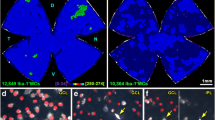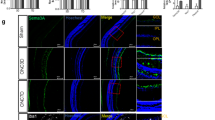Abstract
Background
Optic nerve transection results in degeneration of axotomized retinal ganglion cells followed by the activation of resident microglial cells.
Methods
An organotypic culture of neonatal rat retina was used to examine the temporal aspect of retinal ganglion cell death and microglial cell recruitment. Retinas were fixed at various times after explantation and prepared for immunohistochemistry and lectin staining.
Results
Terminal deoxytransferase dUTP nick-end labeling (TUNEL) and immunohistochemistry for cleaved caspase-3 demonstrated a massive cascade of cell death in the ganglion cell layer (GCL) within hours after explantation. The rate of cell death in this layer was high and continued over a period of 48 h. In contrast, the rate of cell death was low in the outer nuclear layer (ONL) and apoptotic cells were evident after 6 days in vitro. Increases in the density of microglial cells in the GCL appeared to be recruited by proliferation within hours after explantation. In parallel, resident microglial cells also acquired an activated morphology as revealed by isolectin B4 staining. Microglial cell activation in the GCL also included an upregulated expression for the lysosomal protein ED-1 and the cysteine protease inhibitor cystatin C. After 1 week of culture, immunolabeling for ED-1 demonstrated the presence of activated microglial cells also in the ONL.
Conclusion
These data show rapid microglial cell recruitment and activation following the axotomy-induced cell death of differentiated ganglion cells. The processes of microglial cell activation and cell death are slower in the outer retina.





Similar content being viewed by others
References
Aloisi F (2001) Immune function of microglia. Glia 36:165–179
Ashwell KWS, Holländer H, Streit W, Stone J (1989) The appearance and distribution of microglia in the developing retina of the rat. Vis Neurosci 2:437–448
Bähr M (2000) Live or let die—retinal ganglion cell death and survival during development and in the lesioned adult CNS. Trends Neurosci 23:483–489
Berkelaar MJ, Clarke DB, Wang Y-C, Bray GM, Aguayo AJ (1994) Axotomy results in delayed death and apoptosis of retinal ganglion cells in adult rats. J Neurosci 14:4368–4374
Castagné V, Lefevre K, Natero R, Becker DA, Clarke PGH (1999) An optimal redox status for the survival of axotomized ganglion cells in the developing retina. Neuroscience 93:313–320
Cepko CL, Austin CP, Yang X, Alexiades M, Ezzedine D (1996) Cell fate determination in the vertebrate retina. Proc Natl Acad Sci USA 93:589–595
Chaudhary P, Ahmed F, Quebada P, Sharma S.C. (1999) Caspase inhibitors block the retinal ganglion cell death following optic nerve transection. Mol Brain Res 67(1):36–45
Cuadros MA, Martin D, Pérez-Medoza D, Navascués J, Clarke PGH (2000) Response of macrophage/microglial cells to experimental neuronal degeneration in the avian isthmo-optic nucleus during development. J Comp Neurol 423:659–669
Cusato K, Bosco A, Linden R, Reese BE (2002) Cell death in the inner nuclear layer of the retina is modulated by BDNF. Dev Brain Res 139:325–30
Dreher B, Potts RA, Bennett MR. (1983). Evidence that the early postnatal reduction in the number of rat retinal ganglion cells is due to a wave of ganglion cell death. Neurosci Lett 36:255–260
Garcia-Valenzuela E, Sharma SC (1999) Laminar restriction of retinal macrophagic response to optic nerve axotomy in the rat. J Neurobiol 40:55–66
Garcia-Valenzuela E, Gorczyca W, Darzynkiewicz Z, Sharma SC (1994) Apoptosis in adult retinal cells after axotomy. J Neurobiol 25:431–438
Gavrieli Y, Sherman Y, Ben-Sasson SA (1992) Identification of programmed cell death in situ via specific labeling of nuclear DNA fragmentation. J Cell Biol 119:493–501
Graeber MB, López-Redondo F, Ikoma E, Ishikawa M, Imai Y, Nakajima K, Kreutzberg GW, Kohsaka S (1998) The microglia/macrophage response in the neonatal rat facial nucleus following axotomy. Brain Res 813:241–253
Grasl-Kraupp B, Ruttkay-Nedecky B, Koudelka H, Bukowska K, Brusch W, Schulte-Hermann R (1995) In situ detection of fragmented DNA (TUNEL assay) fails to discriminate among apoptosis, necrosis, and autolytic cell death: a cautionary note. Hepatology 21:1465–1468
Grubb AO (2000) Cystatin C—properties and use as diagnostic marker. Adv Clin Chem 35:63–99
Harvey AR, Cui Q, Robertson D (1994) The effect of cycloheximide and ganglionside GM1 on the viability of retinotectally projecting ganglion cells following ablation of the superior colliculus in neonatal rats. Eur J Neurosci 6:550–557
Horsburgh GM, Sefton AJ (1987) Cellular degeneration and synaptogenesis in the developing retina of the rat. J Comp Neurol 263:553–566
Isenmann S, Wahl C, Krajewski S, Reed JC, Bähr M (1997) Up-regulation of Bax protein in degenerating retinal ganglion cells precedes apoptotic cell death after optic nerve lesion in the rat. Eur J Neurosci 9:1763–1772
Johansson K, Bruun A, Grasbon T, Ehinger B (2000) Growth of postnatal rat retina in vitro: development of neurotransmitter systems. J Chem Neuroanat 19:117–128
Kermer P, Klöcker N, Labes M, Bähr M (1998) Inhibition of CPP32-like proteases rescues axotomized retinal ganglion cells from secondary cell death in vivo. J Neurosci 18:4656–4662
Kermer P, Klöcker N, Labes M, Thomsen S, Srinivasan A, Bähr M (1999) Activation of caspase-3 in axotomized rat retinal ganglion cells in vivo. FEBS Lett 453:361–364
Koliatsos VE, Price WL, Pardo CA, Price PL (1994). Ventral root avulsion: an experimental model of death of adult motor neurons. J Comp Neurol 342:35–44
Kreuger-Naug AMR, Emsley JG, Myers TL, Currie RW, Clarke DB (2002) Injury to retinal ganglion cells induces expression of the small heat shock protein Hsp27 in the rat visual system. Neuroscience 110:653–665
Kreutzberg GW (1996) Microglia: a sensor for pathological events in the CNS. Trends Neurosci. 19:312–318
Lawson LJ, Perry VS, Gordon S (1992) Turnover of resident microglia in the normal adult mouse brain. Neuroscience 48:405–410
Linden R, Rehen SK, Chiarini LB (1999) Apoptosis in developing retinal tissue. In: Osborne NN, Chader GJ. (eds) Progress in retinal and eye research, vol 18. Elsevier, Amsterdam pp 133–165
Mansour-Robaey S, Clarke DB, Wang YC, Bray GM, Aguayo AJ (1994) Effects of ocular injury and administration of brain-derived neurotrophic factor on survival and regrowth of axotomized retinal ganglion cells. Proc Natl Acad Sci USA 5:1632–1636
Mertsch K, Hanisch U-K, Kettenman H, Schnitzer J (2001) Characterization of microglial cells and their responses to stimulation in an organotypic retinal culture system. J Comp Neurol 431:217–227
Mey J, Thanos S (1993) Intravitreal injections of neurotrophic factors support the survival axotomized retinal ganglion cells in adult rats in vivo. Brain Res 602:304–317
Milligan CE, Levitt P, Cunningham TJ (1991) Brain macrophages and microglia respond differently to lesions of the developing and adult visual system. J Comp Neurol 314:136–146
Naskar R, Wissing M, Thanos S (2002) Detection of early neuron degeneration and accompanying microglial responses in the retina of a rat model of glaucoma. Invest Ophthalmol Vis Sci, 43:2962–2968
Nishio C, Yoshida K, Nishiyama K, Hatanaka H, Yamada M (2000) Involvement of cystatin C in oxidative stress-induced apoptosis of cultured rat CNS neurons. Brain Res 873:252–262
Perry VH, Henderson Z, Linden R (1983). Postnatal changes in retinal ganglion cell and optic axon populations in the pigmented rat. J Comp Neurol 219:356–368
Rabacchi SA, Bonfanti L, Liu XH, Maffei L (1994) Apoptotic cell death induced by optic nerve lesion in the neonatal rat. J Neurosci 14:5292–5301
Rehen SK, Linden R (1994) Apoptosis in the developing retina:paradoxical effects of protein synthesis inhibition. Braz J Med Biol Res 27:1647–1651
Rehen SK, Varella MH, Freitas FG, Moraes MO, Linden R. (1996). Contrasting effects of protein synthesis inhibition and of cyclic AMP on apoptosis in the developing retina. Development 12:1439–1448
Rosenstiel P, Lucius R, Deuschl G, Sievers J, Wilms H (2001) From theory to therapy: implications from an in vitro model of ramified microglia. Microsc Res Technol 54:18–25
Streit JW, Walter SA, Pennell NA (1999) Reactive microgliosis. Prog Neurobiol 57:563–581
Thanos S (1991) The relationship of microglial cells to dying neurons during natural neuronal cell death and axotomy-induced degeneration of the rat retina. Eur J Neurosci 3:1189–1207
Thanos S, Mey J, Wild M (1993) Treatment of the adult retina with microglia-suppressing factors retards axotomy-induced neuronal degradation and enhances axonal regeneration in vivo and in vitro. J Neurosci 13:455–466
Thanos S, Moore S, Hong Y-M (1996) Retinal microglia, In: Chader GJ, Osborne NN (eds) Progress in retinal and eye research, vol 15. Elsevier Science, Amsterdam, pp 331–361
Wassélius J, Håkansson K, Johansson K, Abrahamsson M, Ehinger B (2001) Identification and localization of retinal cystatin C. Invest Ophthalmol Vis Sci 42:1901–1906
Acknowledgements
The Swedish Medical Research Council (13012–01A and 14X-2321), the Foundation Fighting Blindness, and Crown Princess Margret’s Committee for the Blind supported this study, as did the Knut and Alice Wallenberg Foundation, the Crafoord Foundation and the Faculty of Medicine, Lund University.
Author information
Authors and Affiliations
Corresponding author
Rights and permissions
About this article
Cite this article
Engelsberg, K., Ehinger, B., Wassélius, J. et al. Apoptotic cell death and microglial cell responses in cultured rat retina. Graefe's Arch Clin Exp Ophthalmol 242, 229–239 (2004). https://doi.org/10.1007/s00417-003-0780-z
Received:
Revised:
Accepted:
Published:
Issue Date:
DOI: https://doi.org/10.1007/s00417-003-0780-z




